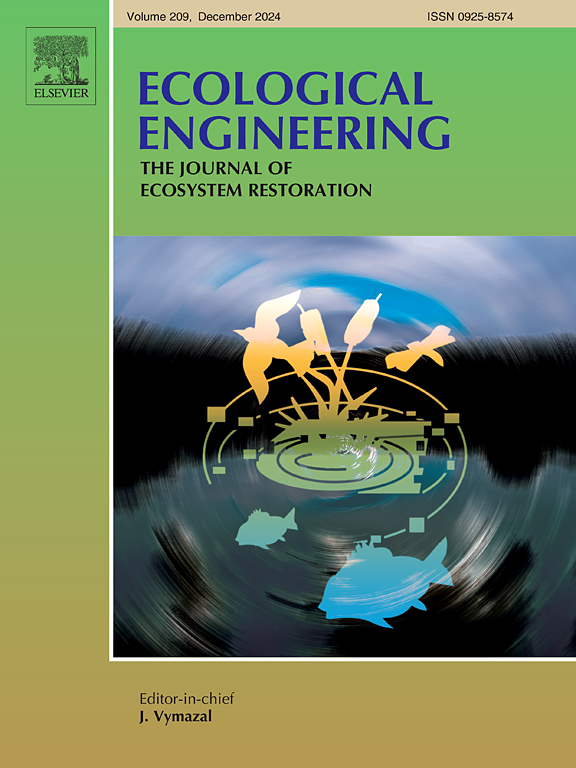Exploring ecosystem service dynamics and drivers in the upper and middle Yellow River Basin under large-scale ecological restoration
IF 3.9
2区 环境科学与生态学
Q1 ECOLOGY
引用次数: 0
Abstract
The upper and middle of the Yellow River Basin (UMYRB) are globally recognized as an ecologically fragile region due to severe soil erosion, arid climate, and frequent extreme weather events. Over the past two decades, large-scale ecological restoration measures have led to pronounced changes in ecosystem services (ES). However, there is a lack of systematic analysis addressing the spatiotemporal dynamics and driving mechanisms of multiple ecosystem services under the combined effects of ecological restoration projects and extreme climatic events. To fill this gap, this study employed the InVEST model, geographically weighted regression, and partial least squares structural equation modeling to comprehensively investigate the evolution of various ecosystem services in this basin and their key influencing factors. The results indicate that (1) in regions where vegetation recovery was particularly successful, water yield (WY) increased from 24 mm to 88 mm and soil conservation (SC) capacity was substantially enhanced; carbon storage (CS) rose by approximately 12 % in the humid southern area but remained stable in the arid northern region. (2) Precipitation, slope, vegetation cover, and land-use changes collectively shaped the spatial patterns of ecosystem services, with precipitation exhibiting the strongest explanatory power for WY, and slope together with vegetation recovery exerting notable impacts on SC. (3) In areas of vegetation recovery, multiple ecosystem services showed stronger synergy, whereas habitat quality (HQ) and CS exhibited significant trade-offs in regions experiencing agricultural expansion. (4) Extreme precipitation events markedly amplified the variability of WY, SC, and CS, accounting for 61.5 %, 57.8 %, and 27.4 % of their respective variances, while exerting relatively limited effects on HQ. These findings elucidate the mechanisms by which ecological restoration projects and extreme precipitation events jointly influence multiple ecosystem services, and provide scientific guidance for targeted ecological management and service optimization in UMYRB.
大规模生态修复条件下黄河中上游生态系统服务动态及驱动因素研究
黄河中上游地区水土流失严重,气候干旱,极端天气频发,是全球公认的生态脆弱区。近20年来,大规模的生态恢复措施导致了生态系统服务功能的显著变化。然而,在生态修复工程和极端气候事件共同作用下,多种生态系统服务功能的时空动态及其驱动机制缺乏系统的分析。为了填补这一空白,本研究采用InVEST模型、地理加权回归和偏最小二乘结构方程模型对该流域各种生态系统服务功能的演变及其关键影响因素进行了综合研究。结果表明:(1)在植被恢复特别成功的地区,产水量从24 mm增加到88 mm,土壤保持能力明显增强;在湿润的南部地区,碳储量增加了约12%,而在干旱的北部地区则保持稳定。(2)降水、坡度、植被覆盖和土地利用变化共同塑造了生态系统服务的空间格局,其中降水对WY的解释能力最强,坡度和植被恢复对SC的影响显著。(3)在植被恢复区域,多种生态系统服务表现出更强的协同效应,而在农业扩张区域,栖息地质量(HQ)和CS表现出显著的权衡关系。(4)极端降水事件显著放大了WY、SC和CS的变率,分别占其方差的61.5%、57.8%和27.4%,而对HQ的影响相对有限。这些发现阐明了生态修复工程与极端降水事件共同影响多种生态系统服务的机制,为UMYRB有针对性的生态管理和服务优化提供了科学指导。
本文章由计算机程序翻译,如有差异,请以英文原文为准。
求助全文
约1分钟内获得全文
求助全文
来源期刊

Ecological Engineering
环境科学-工程:环境
CiteScore
8.00
自引率
5.30%
发文量
293
审稿时长
57 days
期刊介绍:
Ecological engineering has been defined as the design of ecosystems for the mutual benefit of humans and nature. The journal is meant for ecologists who, because of their research interests or occupation, are involved in designing, monitoring, or restoring ecosystems, and can serve as a bridge between ecologists and engineers.
Specific topics covered in the journal include: habitat reconstruction; ecotechnology; synthetic ecology; bioengineering; restoration ecology; ecology conservation; ecosystem rehabilitation; stream and river restoration; reclamation ecology; non-renewable resource conservation. Descriptions of specific applications of ecological engineering are acceptable only when situated within context of adding novelty to current research and emphasizing ecosystem restoration. We do not accept purely descriptive reports on ecosystem structures (such as vegetation surveys), purely physical assessment of materials that can be used for ecological restoration, small-model studies carried out in the laboratory or greenhouse with artificial (waste)water or crop studies, or case studies on conventional wastewater treatment and eutrophication that do not offer an ecosystem restoration approach within the paper.
 求助内容:
求助内容: 应助结果提醒方式:
应助结果提醒方式:


